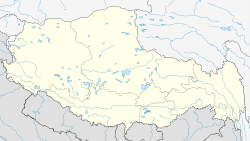- Mission de l'Inde à Lhassa
-

Mission de l'Inde à Lhassa 

Inde
TibetLieu Lhassa Coordonnées Nomination 15 août 1947 Géolocalisation sur la carte : Région autonome du Tibet
Voir aussi : Bureau du Tibetmodifier 
La Mission de l'Inde à Lhassa ouverte le 15 août 1947 vit son statut modifié en Consulat général en 1952 avant d'être fermée en 1962 lors de la guerre sino-indienne.
Sommaire
Histoire
La Mission de l'Inde à Lhassa est ouverte lors de l'accession de l'Inde à l'indépendance le 15 août 1947, remplaçant la mission britannique à Lhassa (1936-1947)[1],[2].
Selon ses propres dires publiés sur le site du gouvernement tibétain en exil, Sonam T. Kazi fut interprète et traducteur auprès de la mission indienne au Tibet entre 1949 et 1956[3].
Le 1er avril 1950, l'Inde reconnut officiellement la République populaire de Chine [4].
En mai 1951, l'accord en 17 points fut signé sous la contrainte selon l'historien indien N. Jayapalan, et le Tibet devint une région de la Chine. Le 16 septembre 1952[5], les gouvernement de l'Inde et de la Chine annoncèrent leur accord de changer le statut de la mission en un Consulat général[6].
En octobre 1962, lors de la guerre sino-indienne, le consulat indien à Lhassa fut fermé. En août 2009, Pékin évoqua la possibilité qu'il soit réouvert[7],[8].
Liste des chefs de la Mission
- Hugh Richardson (15 août 1947- août 1950)[9]
- S. Sinha [10],[11] (août 1950 - septembre 1952)
Liste de Consul généraux
- AK Sen[12]
Notes et références
- (en) Heinrich Harrer, Seven years in Tibet, translated from the German by Richard Graves; with an introduction by Peter Fleming; foreword by the Dalai Lama, E. P. Dutton, 1954 : « India's declaration of independence settled the fate of the British Legation in Lhasa ».
- (en) Obituary -- Dr Hugh Richardson, The Scotsman, 7th December 2000, reproduit sur le site du Comité Canada Tibet : {{Citation étrangère[langue=en|He returned to Lhasa after the end of the war as British representative and when Britain left India in 1947 after it was awarded self-government he remained in Tibet as the representative of the Indian government as officer in charge of the Indian Mission.}}
- (en)A brief account of Mr. Sonam T. Kazi's experience in Tibet before the Chinese Invasion, 13 septembre 1994.
- (en) For Taiwan, India's in the slightly-less-hard basket : « India was one of the few nations that established official ties with the People's Republic of China, rather than the exiled Republic of China government on Taiwan, in 1950 ».
- C. H. Alexandrowicz, India and the Tibetan Tragedy, Foreign Affairs, avril 1953
- N Jayapalan, India and her neighbours, Atlantic Publishers & Dist, 2000,(ISBN 8171569129 et 9788171569120), p. 8
- Claude Arpi, An Indian Consulate in Lhasa?
- India can reopen consulate in Lhasa:Chinese foreign ministry official, 25 août 2009
- Lowell Thomas (en), Out of this world: across the Himalayas to forbidden Tibet, 1954, Greystone Press, p. 110 : « But Richardson had no intention of remaining permanently behind the Himalayas. In fact, in August, 1950, he relinquished his post as political officer and trade agent to Dr. S. Sinha of the External Affairs Ministry at Delhi. »
- Iqbal Singh, Between two fires: towards an understanding of Jawaharlal Nehru's foreign policy, Volume 2, Orient Blackswan, 1998 (ISBN 812501585X et 9788125015857), p. 219
- Claude Arpi, The History of a Consulate
- Karunakar Gupta, Sino-Indian relations, 1948-52: role of K.M. Panikkar, Netaji Institute for Asian Studies - 1987 p. 75 : « AK Sen became our first Consul-General in Lhasa »
Catégories :- Ambassade au Tibet
- Ambassade en Chine
- Relations bilatérales du Tibet
- Relations bilatérales de l'Inde
- Relations bilatérales de la Chine
- Fondation en 1947
- Organisme disparu en 1962
Wikimedia Foundation. 2010.

